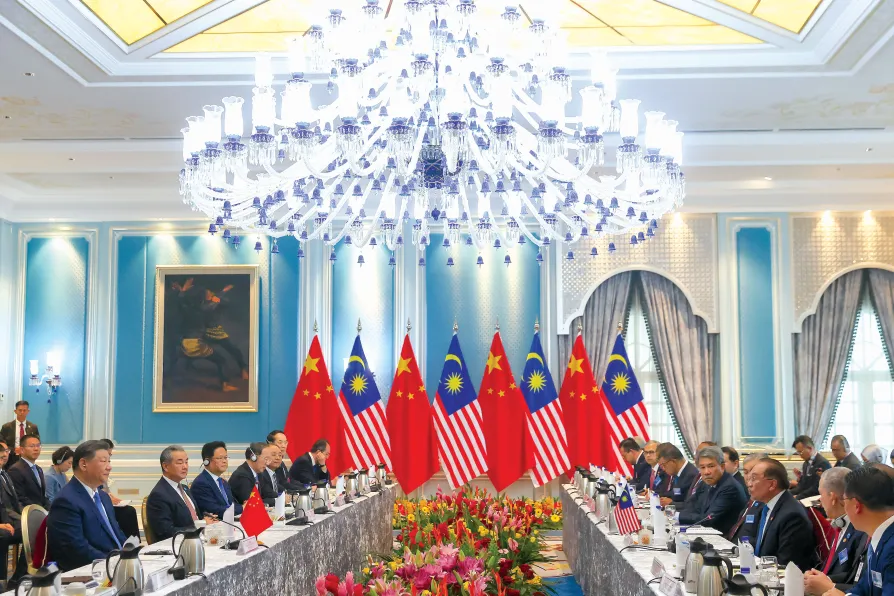From London’s holly-sellers to Engels’s flaming Christmas centrepiece, the plum pudding was more than festive fare in Victorian Britain, says KEITH FLETT
DONG XUE explains why US tariffs hold no significant threat to China

 SEIZING THE DAY: Chinese President Xi Jinping and Malaysian Prime Minister Anwar Ibrahim, (first from left and right respectively) attend the bilateral meeting between the Malaysian and the Chinese delegations
SEIZING THE DAY: Chinese President Xi Jinping and Malaysian Prime Minister Anwar Ibrahim, (first from left and right respectively) attend the bilateral meeting between the Malaysian and the Chinese delegations
BEIJING’S resolve is stronger than ever. One clear sign of this is JD.com’s recent initiative, which aims to redirect the focus of Chinese exporters to China’s vast domestic market. In response to the tariff battle with the US, the e-commerce giant has launched a massive 200 billion yuan ($27.4bn) programme to bolster trade within its own borders, tapping into the purchasing power of its 1.4 billion citizens.
JD.com is not alone in this move; Alibaba Group’s Freshippo and the food delivery service Meituan have also stepped up with similar initiatives.
These programmes aren’t just about mitigating losses from US tariffs — they represent a strategic pivot that could ultimately help Chinese companies capture a larger share of the domestic market.
This shift is part of Beijing’s broader “dual circulation” strategy, which prioritises the domestic economy while reducing dependency on an increasingly hostile global environment. The approach gained momentum after the pandemic in 2020, but it’s clear now that the move is designed with a long-term vision.
Before the tariff war began, the US was an important trading partner for China. But to put it into perspective, US-China trade accounted for only about 2 per cent of China’s GDP.
In fact, according to China’s National Bureau of Statistics, exports to the US made up 14.7 per cent of China’s total exports in 2022, down from 19.2 per cent in 2018. While the total export value increased, the share going to the US decreased — showing China’s success in diversifying its export markets and reducing its reliance on US demand.
This is why, despite White House claims that China is facing a 245 per cent tariff on its imports to the US, Beijing will not surrender. The number itself has become largely symbolic — it no longer holds practical significance.
In the meantime, the President of China, Xi Jinping, has wrapped up a three-nation tour of south-east Asia, where he signed a slew of memorandums of understanding covering everything from security co-operation to rail development.
Throughout his trip, Xi emphasised China’s large market as a valuable opportunity for its neighbours, reaffirming Beijing’s commitment to global trade leadership and economic growth.
Further signalling its stance, China recently unveiled a comprehensive policy framework in response to the escalating trade war. The white paper, issued by the State Council Information Office, stresses the mutually beneficial nature of China-US trade and calls for dialogue to resolve disputes. It warns that the imposition of tariffs by the US would ultimately backfire, while still leaving room for negotiation on equal footing.
“History and reality have shown that raising tariffs will not solve the US’s own problems,” the Chinese Ministry of Commerce said in a statement accompanying the white paper. “Instead, it triggers market volatility, fuels inflation in the US, erodes its industrial base, and increases the risk of economic recession. Ultimately, the US will only suffer the consequences itself.”
All signs point to the fact that China has options — many options — on the table. From diversifying its trade partnerships to expanding its domestic market, Beijing is clearly committed to weathering the storm.
In the end, while Washington may hope for a quick resolution, Beijing is playing the long game — and, so far, it looks like it’s in a position of strength, and certainly, not backing down.
Dong Xue is diplomatic reporter for CGTN. Follow her on X: @theserenadong.














